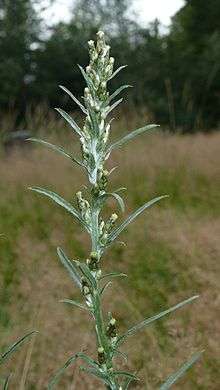Gnaphalium sylvaticum
| Gnaphalium sylvaticum | |
|---|---|
 | |
| Scientific classification | |
| Kingdom: | Plantae |
| (unranked): | Angiosperms |
| (unranked): | Eudicots |
| (unranked): | Asterids |
| Order: | Asterales |
| Family: | Asteraceae |
| Tribe: | Gnaphalieae |
| Genus: | Gnaphalium |
| Species: | G. sylvaticum |
| Binomial name | |
| Gnaphalium sylvaticum L. 1753 | |
| Synonyms | |
|
Synonymy
| |
Gnaphalium sylvaticum, commonly known as heath cudweed,[1] wood cudweed, golden motherwort, chafeweed, and owl's crown.[2] is a species of plants in the sunflower family. It is widespread across much of Europe.[3] The species was first formally described by Carl Linnaeus in 1753.[4]
Description
It is a perennial herb with short runners.[5]
The plant is 8 to 60 cm tall.[5]
The leaves are lanceolate in shape, pointed, 2 to 8 cm long, with a single vein. They have no hair on top, but are woolly hairy below. The upper leaves become progressively shorter and narrower.[5]
The flower heads are 6mm long. The bracts of the flower heads have a green centre, and chaffy brown edges. The florets are pale brown. The achenes are hairy with reddish pappus hairs.[5]
It flowers from July until September.[5]
References
- ↑ "BSBI List 2007". Botanical Society of Britain and Ireland. Archived from the original (xls) on 2015-01-25. Retrieved 2014-10-17.
- ↑ An illustrated flora of the northern United States: Canada and the British possessions from Newfoundland to the parallel of the southern boundary of Virginia, and from the Atlantic ocean westward to the 102d meridian, Volume 3, 1898, p. 403.
- ↑ Altervista Flora Italiana, Gnaphalium sylvaticum L. includes photos and European distribution map
- ↑ "Plant Name Details" (HTML). International Plant Names Index (IPNI). International Organization for Plant Information (IOPI). Retrieved 18 March 2009.
- 1 2 3 4 5 Rose, Francis (1981). The Wild Flower Key. Frederick Warne & Co. pp. 377–380. ISBN 0-7232-2419-6.
| Wikimedia Commons has media related to Gnaphalium sylvaticum. |
External links
- Online Atlas of the British and Irish flora, Gnaphalium sylvaticum (Heath Cudweed)
- Gnaphalium sylvaticum - (Omalotheca sylvatica) Botanik im Bild / Flora von Österreich